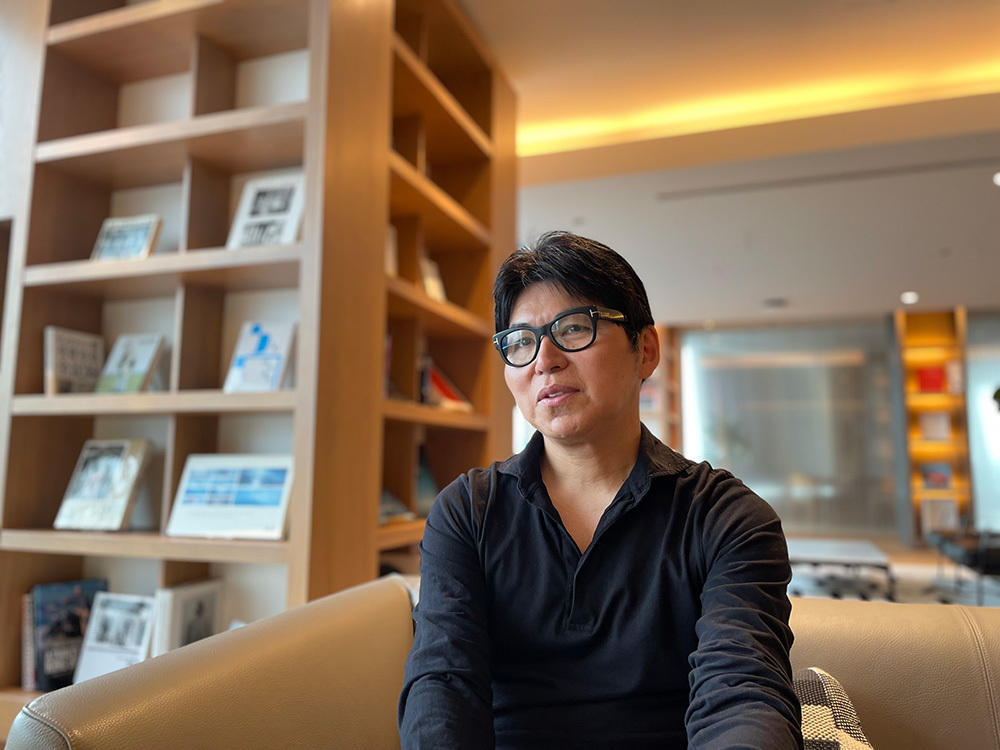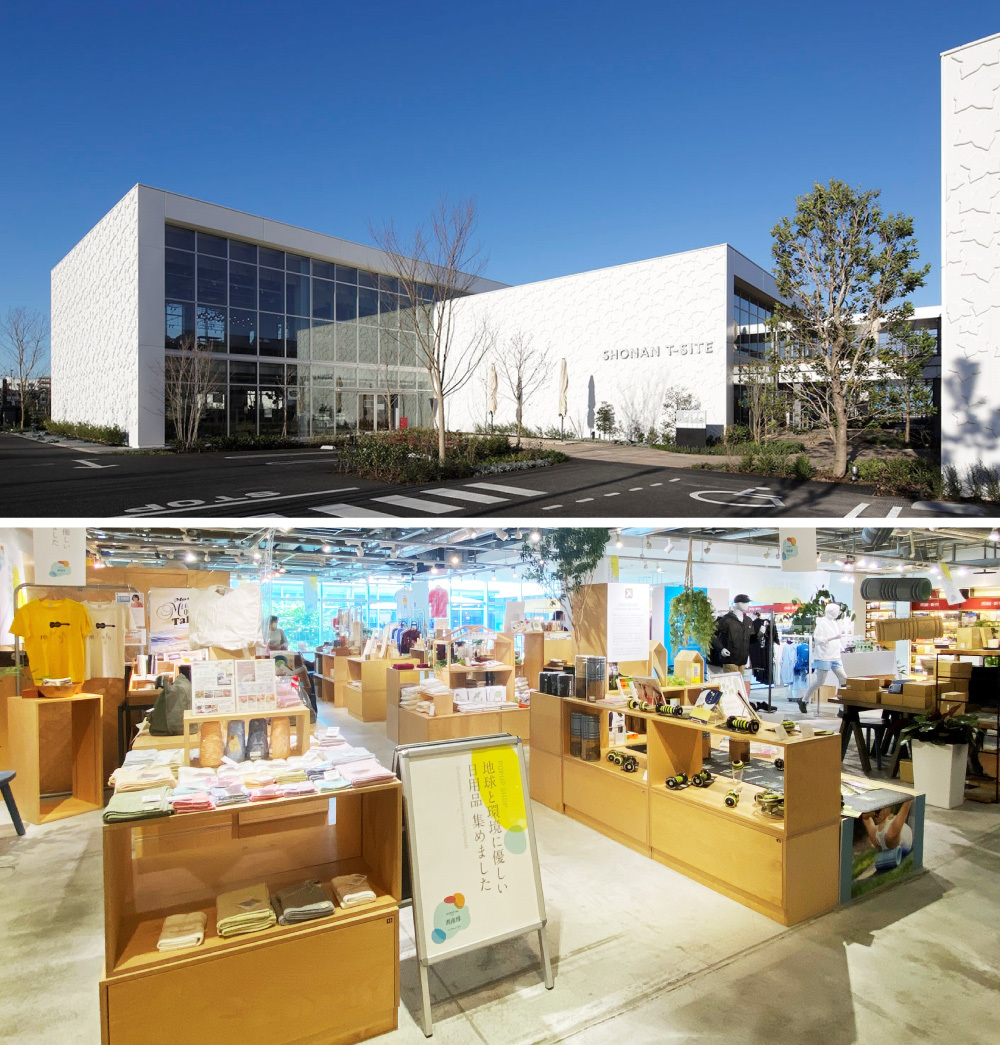In the sustainable era, "Tsutaya Books" becomes a community!
This series explores hints for achieving the SDGs and realizing a sustainable society. This time, we speak with Takahiro Kamata, Head of the Media Business Division at Culture Convenience Club Co., Ltd. - Tsutaya Books Company, who oversees the launch of Tsutaya Books and the commercial facility "T-SITE" centered around Tsutaya Books.
"Tsutaya Books can become a community hub for realizing a circular society," says Mr. Kamata. He shared insights on the importance of each store having its own concept, creating opportunities for customers to personalize the SDGs, and his vision for a real-world media platform.

Tsutaya Books can become a community that fosters customer "empathy"
──Culture Convenience Club operates "TSUTAYA" and "Tsutaya Bookstore." When "Daikanyama Tsutaya Bookstore" opened in 2011, it became a major talking point. I understand you led that launch.
Kamata: For Daikanyama Tsutaya Bookstore, amidst Japan's declining birthrate and aging population, we set the target persona as those in their 60s and aimed to create an "adult Tsutaya." We positioned it as a place where adults, having accumulated diverse experiences, could propose mature culture across various genres like art, living, travel, and food. A key feature of the Daikanyama location is that it forms a commercial complex called "T-SITE," where unique shops seamlessly connect around the core of Tsutaya Books. Over ten years since opening, it's used not only by those in their 60s but by a wide range of age groups.
──Mr. Kamata, besides Daikanyama, you've also launched T-SITE in Fujisawa, Kashiwanoha, Hirakata in Osaka, and Hiroshima. What is the aim behind creating commercial facilities centered around Tsutaya Bookstore?
Kamata: Due to changes in the times, such as digitalization, the number of new book releases has decreased, magazines are suspending or ceasing publication one after another, and bookstores are disappearing rapidly. Times are changing, and we can't survive on merchandise sales alone. By sharing more information, offering experiences, and building a community centered around Tsutaya Books, we believe we can foster a sense of "empathy" among our customers. We see this as the future significance of Tsutaya Books, and we genuinely feel our customers are seeking this kind of role from us.
Our company has always operated stores under the philosophy of being a "planning company," with "lifestyle proposals" as our banner. Some stores house various tenants, and we also have relationships with manufacturers. T-SITE plays a role in community development, expanding connections with local public organizations. By leveraging the planning capabilities and networks we've cultivated, we should be able to transcend the boundaries of being just a "bookstore."
Furthermore, the books and magazines we primarily handle can be seen as outlets for our editorial skills and spirit of inquiry. By teaming up with authors and editors, we can propose more multidimensional projects to the world. We can also collaborate with various experts and leading figures in different fields to disseminate information linked to our content, and we have already begun such initiatives.
Within the context of sustainability and SDGs, physical spaces like Tsutaya Bookstore and T-SITE can contribute significantly toward realizing a circular society. Indeed, even during the current publishing slump, visitor numbers to Tsutaya Bookstore have not declined. I believe this reflects customers' continued appreciation for the value of discovery and experience within physical spaces.
Building a community requires a concept
──What is necessary for Tsutaya Bookstore and T-SITE to fulfill their role as communities?
Kamata: It's about having a clear concept—understanding the values and philosophy that the store exists to embody.
Before the pandemic, when we held about 2,000 events and workshops at commercial facilities over two years, seeing 20,000 to 30,000 customers visit made me realize firsthand that customers seek genuinely enjoyable real-life experiences.
However, I also realized that simply doing fun things tends to be fleeting. Customers might only gather when there's an interesting event. That won't deepen the relationship or trust between customers and Tsutaya Books. That's why each store needs its own concept. This concept must be shared with everyone involved: the staff working at the store, the customers, the business partners, and even those who share information in the wider world. What should the concept be? It should align with the interests and concerns of the residents in each local community where the store is located.
──Could you give a specific example of a T-SITE concept?
Kamata: Following Daikanyama, we launched Shonan T-SITE in Fujisawa in 2014. This is something we should reflect on, but when Shonan T-SITE first opened, we adopted the concept of "becoming the premier place to propose slow food and slow living." Slow food and slow living were gaining attention at the time. Shonan T-SITE is located within Fujisawa Sustainable Smart Town and is close to the ocean. We believed it perfectly aligned with the lifestyle of the people living in this area. However, this concept failed to resonate at all—not with our customers, not with the people working at T-SITE, and not with our business partners.
At Shonan T-SITE, we partnered with "SHONAN TIME," a culture magazine promoting the Shonan lifestyle, to launch the "Shonan Expo" project in 2019. That time, we held it under the broad theme of "Things Born in Shonan." Back then, both Shonan T-SITE's concept and the themes of the events held there felt rather vague; it's hard to say they were properly aligned with the interests and concerns of the residents.
For the second Shonan Expo, held from April 29, 2022, for about a month, we felt it necessary to rethink the very concept of Shonan T-SITE itself when planning the event.
So, we revisited who our customers at Shonan T-SITE really are. Fujisawa Sustainable Smart Town has advanced infrastructure, with goals like using over 30% renewable energy and reducing CO2 emissions by 70%. Each household embodies sustainable living, for example, by generating electricity with solar panels.
While many residents resonate with SDGs and sustainability, surveys revealed that beyond actions like waste sorting or beach cleanups, they often struggled to identify tangible, everyday actions they could take themselves. Expanding the survey area slightly showed that sensitivity to SDGs and sustainability wasn't low, and some residents were indeed engaged in sustainable or ethical initiatives. However, it seemed these efforts weren't sufficiently translating into action among the local community.
Therefore, Shonan T-SITE wanted to become a place where visitors could perceive SDGs and sustainability more personally and find hints to take action. From this, Shonan T-SITE adopted the concept of "becoming a hub aiming for a sustainable, circular society."

──So setting the theme for Shonan T-SITE required deeper consideration of the local area. Could you tell us what was done for the 2nd Shonan Expo?
Kamata: The Shonan Expo adopted the theme "From Shonan, Thinking About the Earth." The magazine "SHONAN TIME," released around the same time, was also edited under this theme. It was designed so visitors could experience the magazine's content in a three-dimensional way at Shonan T-SITE. At Shonan T-SITE, we showcased the efforts of individuals and companies working towards a sustainable society through "50 Things & Items" presented via exhibitions, sales, talk shows, and live events.
To make SDGs and a sustainable society feel personally relevant, we needed to address topics that local people care about. And to gain their empathy, it was crucial to have messages from people respected by the community. So, we aimed to gather many such individuals.
For example, under the theme "Messages from Books," we created a corner featuring books about the SDGs. Recognizing Shonan's deep-rooted surf culture, we showcased books by leading figures in that culture and provided them a platform to share their messages. We believed that by exposing visitors to such information, we could help broaden their perspectives, making them think, "So this is what sustainability means."

──What kind of response did you get from others after setting the theme "Aiming for a Sustainable Circular Society" for your activities?
Kamata: We felt tremendous expectations from cultural figures, social activists, manufacturers developing products centered on SDGs and sustainability, and even local governments. When we created and submitted a proposal for the Shonan Expo, many people responded with, "That's great, we definitely want to participate," which was hugely encouraging.
Tsutaya Books can become a real-world media platform
──How do you envision the future of Shonan T-SITE?
Kamata: We definitely want to continue initiatives like the Shonan Expo. Next time, we're thinking of making it symposium-style. When people hear "peace symposium," many think of Hiroshima and Nagasaki. We want to work towards making Shonan the place people associate with sustainability and SDGs symposiums.
Furthermore, we're considering making it an open platform starting next time. We want to invite a wider range of people and companies for each theme, and we could also invite local residents who embody SDGs and sustainable living with a high level of awareness.
Rather than us handling everything, a participatory approach based on themes seems more likely to create a significant wave of change. To put it bluntly, if 120 million people lived with this mindset, Japan would become a sustainable society. Therefore, we want to plan broader outreach and experiences, not just communicate the ideas of a limited few.
Additionally, there's another T-SITE in Kashiwanoha, Chiba Prefecture, located within a larger smart town than Fujisawa. We're considering holding simultaneous events in Shonan and Kashiwanoha next time.
──My imagination is really running wild. In community building and regional revitalization, there are often cases where the substance doesn't quite follow, causing difficulties. What are the key points or approaches for involving local people and building a culture together?
Kamata: I get asked that a lot. Ultimately, you just have to engage. It's probably the same for companies, right? Engaging with new employees, engaging with the president... If you put up walls between yourself and others, I don't think culture can be cultivated.
When you encounter complaints or unpleasant experiences while working on various initiatives, it can make you hesitate to push further. But I want you to think about the purpose of community building. If the future becomes better, everyone will be happy, right? Even if there are some complaints, if the initiative has broad support, you should keep moving forward.
Conversely, if your efforts aren't gaining significant support, it might mean your activities aren't timely enough. When planning something, you market it through various channels, right? I ask people who offer constructive criticism in my daily work, "Do you think this will make people happy?" If they say, "Yeah, that sounds good," I push forward with it. You just have to face it head-on. Well, in my case, I guess it's about facing marketing.
I believe Tsutaya Bookstore and T-SITE can become real media platforms. Various people, companies, and organizations share information, which then spreads locally and sparks action... If we can elevate it to that level, our value within a circular society should increase. We'll continue exploring and shaping what only Tsutaya Bookstore can do.

TeamSDGs collaborates with various SDGs stakeholders to disseminate information about the SDGs and plan/develop solutions.
※ See also Mr. Takahiro Kamata's article here:
Shonan T-SITE's Challenge: SDGs × Building Local Community ~ Culture Convenience Club, Takahiro Kamata
Was this article helpful?
Newsletter registration is here
We select and publish important news every day
For inquiries about this article
Back Numbers
Author

Takahiro Kamata
Culture Convenience Club Co., Ltd.
After graduating from university, he worked at a building materials manufacturer before joining Culture Convenience Club. After serving as store manager at locations including SHIBUYA TSUTAYA, he became project leader for Daikanyama Tsutaya Bookstore and spearheaded the launch of the T-SITE business, starting with Shonan T-SITE. Currently, he is involved in planning manufacturer promotions and collaborative projects centered around the facility concepts of various Tsutaya Bookstores and T-SITE locations. Shonan T-SITE is tied to the town's concept and has been developed from its inception with the concept of "becoming a hub aiming for a sustainable, circular society."


